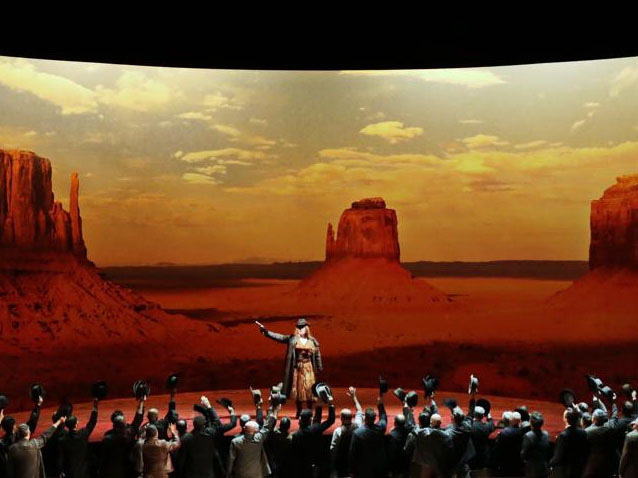 © DR
© DR
With the current La Scala production of Puccini’s La fanciulla del West Robert Carsen reminds us where opera comes from and what it originally dealt with: myth. Not of course classical myth of late-Renaissance Florentine earliest operas, but rather the modern myth Puccini chose after Madama Butterfly to experiment a further path in the hey-day of his success: the myth of the Golden West – as the title of David Belasco’s original play calls it. A myth which has been able to fuel a century-long tradition especially in cinema. Although the genre is far from being over, its tradition might already be historicized, addressed to as a myth of its own and contemplated as a distant – and therefore utterly fascinating – object. This is the kind of operation the Canadian director offers La Scala’s familiar audience: a powerful retrospective on the double myth of Golden West (the historical one and its representation through the movies) which turns into an insightful retrospective on the entire 20th century both cinema and one of Puccini’s most innovative works belong to.
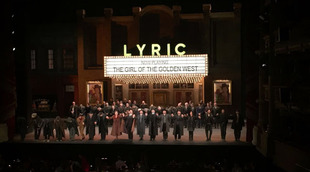
Cinema and its memory encompass the entire show: the miners are watching a western movie when the curtain raises in the breathtaking, abrupt (both visually and musically) start of the opera. A film makes up for the walls of Minnie’s house at the outset of Act 2 (one more curtain in a staging which exploits curtains systematically). In Act 3 cowboys riding in the forests are projected in the background, effectively melding video and the stage action, as the miners sing and dance their orgiastic “Urrah”, raising their guns, preparing the climate for the impressive giant noose hanging from the ceiling. Finally, the drama’s denouement couldn’t take place anywhere else than in a cinema. In the final scene of the drama Minnie and Johnson show up elegantly dressed as cinema stars, while the stage has turned into the facade of a early-19th-century cinema where they are playing The Girl of the Golden West, presumably Robert Z. Leonard’s 1938 popular movie. As the music ends and the couple has disappeared in the backstage, the miners buy their tickets and enter silently the cinema to watch the story they have been acting in.
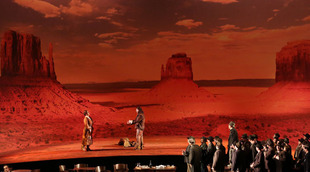
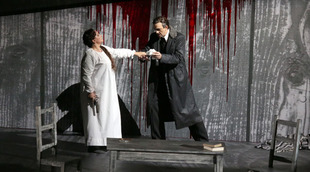
That California landscape and its flavor, the Cloudy Mountains’ couleur locale were essential to the success of the opera was absolutely clear to Puccini and his publisher Ricordi right from the start, as the two California giant sequoia trees framing the setting sun on the cover of the original print libretto demostrate. The desert is Minnie’s background at her entrance as it is at the end of Act 1, while California woods materialize punctually at the outset of act 3. Minnie’s surprise entrance turns into marvelous apparition: a dreamlike epiphany as the wooden structure at the back of the stage – inspired to Buffalo Bill’s Bar in Irma Hotel in Cody (Wyoming) – lifts up completely and discover the picture of the wide landscape of the Grand Canyon, dimmed in the sunset light (not so distant from the one you can see in some recent mobile international advertisement). Alone, in the center of the stage, Minnie appears as coming from another dimension, in her western attire, holding a gun in her right hand.
Carsen is quite clever in managing the masses on the very often crowded stage of this choral opera, right from the start of it, when the cinema is swiftly transformed into the Polka saloon with miners gambling at its tables. In Act 2 the men (whose coats look menacing through the entire opera) investigating in Minnie’s house, a wooden room looking like a cave, spacious but at the meantime haunting and somewhat claustrophobic, project haunting shadows on the walls. Johnson’s presence in the house, as far as the libretto goes, is revealed by a few drops of his blood dripping from the floor above; Carsen – assisted in set designing by Luis Carvalho – transforms those drops into the ominous pulp vision of streams of blood oozing on the back wall, shed with a blinding white light: something which did not go unnoticed to old ladies in the audience and which confirms the mythical – not realistic – interpretation of the director’s vision, together with its movie-like aesthetics.
The second remarkable feature in La Scala’s production is Riccardo Chailly’s conduction, warmly acclaimed by the audience. In the contest of a broader 2015-2022 project of new staging of all of Puccini’s operas at La Scala, the performance itself has been preceded by an important preliminary work. La Scala’s Principal Conductor has gone back to the original score, which had been altered (mainly strengthened by doubling instruments and changing dynamics) by Toscanini for the Met premiere of the opera in 1910. This reconstruction, aside restoring smaller sections especially in Act 1, has generally allowed appreciating subtler, more delicate orchestral nuances. And Fanciulla’s orchestration is indeed full of nuances, carefully rendered by Chailly’s sensitive and empathic conduction, attentive to give appropriate intelligibility to small sentences but in the meantime to build unity in the scene, changing abruptly from wild fortissimo to glassy atmospheres, transforming the expressionistic climax of the couple’s kiss in Act 2 into the sweetest elegy of a tender love duet, making the audience feel the magic of the snow falling on the evening mountain landscape, but also willing to conjure the double-basses dominated dull atmosphere at the outset of Act 3, reportedly one of Chailly’s favorite moments. The orchestra acts empathically towards Minnie’s long melodies, but it’s also able to follow the miners’ movements on the stage, managing effectively the high rhythmic and polyphonic demands of the score. In what is possibly Puccini’s most symphonic score (almost a Wagnerian continuum), Chailly supports with a powerful strive Minnie’s and Johnson’s duet which ends act 1, and succeeds in devoting a powerful miniature symphonic poem to Johnson’s attempted execution.
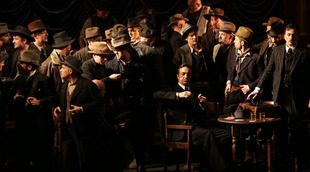
La Fanciulla del West is a choral work performed by an unusual number of secondary roles (no less than 15!). In La Scala’s staging they all behaved very well: so did the miners as the only other woman of the cast, Alessandra Visentin (Wowkle), as well as La Scala Choir instructed by Bruno Casoni. Acting and singing was always quite convincing and transparent – not an easy task at all. As far as the main roles are concerned, they offered a solid and enjoyable performance, yet far from memorable. Barbara Haveman’s Minnie (the Dutch soprano has originally alternated with Eva-Maria Westbroek, and then substituted the latter, after her withdrawl for health reasons) shows a determination perfectly appropriate to the character’s personality, a mixture of sweetness and virility. She has a nice, ringing voice, especially at ease in the top register; however the lower range of her voice is not as convincing and her Italian diction is far from perfect, with a particularly regrettable false-sounding «Delle storie d’amore?» in Act 2. Claudio Sgura’s Jack Rance is an imposing figure, exhibiting a round, full baritone voice. Roberto Aronica’s Johnson, although perfectly in tune, technically irreproachable and sporting a ringing voice, never conveys the sensation of being totally at ease in his vocal role and partially spoils with a not so smooth opening the only aria of the score, «Ch’ella mi creda libero e lontano», a retrospective dream of gone-by melodramma and a true magical moment in its context, conceived for Caruso but quite memorable still much later in Domingo’s 1991 interpretation on La Scala’s stage.
Raffaele Mellace
the 18 of May, 2016 | Print
Comments